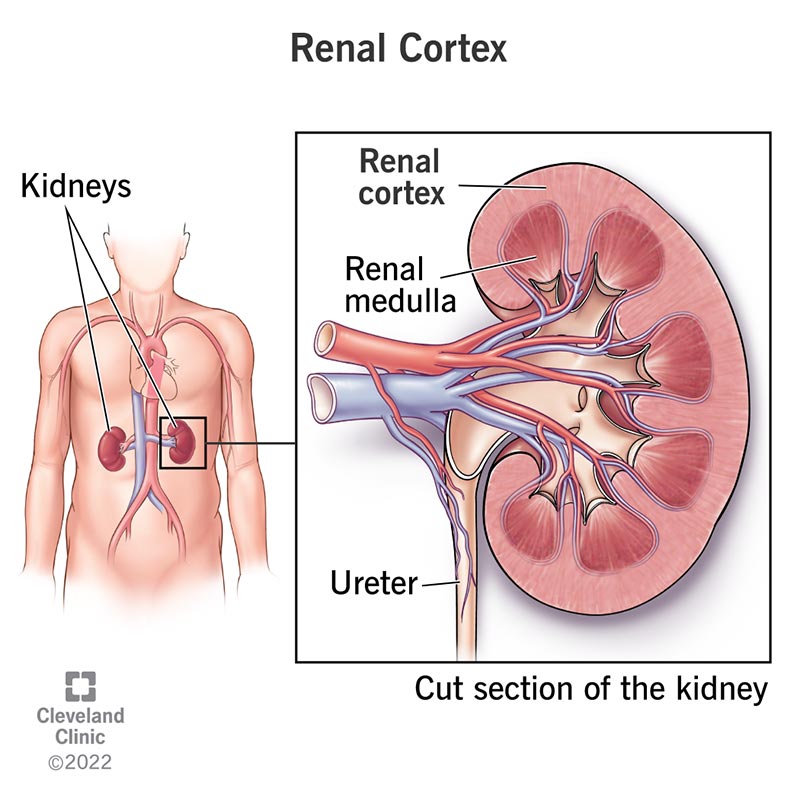The renal cortex, also called the kidney cortex, is a part of your kidney, which is itself part of the urinary tract. The renal cortex is where the filtering units of the kidney begin.
Advertisement
Cleveland Clinic is a non-profit academic medical center. Advertising on our site helps support our mission. We do not endorse non-Cleveland Clinic products or services. Policy

The cortex is the outside layer or covering of many body organs, so the renal cortex is the outer layer of the kidney. The renal cortex is also known as the kidney cortex. The cortex surrounds the inside of the organ, which is called the medulla. The renal cortex itself is covered by the renal capsule, which is a layer of tougher protective tissue.
Advertisement
Cleveland Clinic is a non-profit academic medical center. Advertising on our site helps support our mission. We do not endorse non-Cleveland Clinic products or services. Policy
The renal cortex is where the nephrons (blood-filtering units) begin. Each kidney has 1 million nephrons. The filtering unit of the nephron is the glomerulus, and the glomerulus is attached to a tubule which removes wastes and returns the needed substances to your body. In the renal cortex, the tubules are twisted (convoluted), while in the medulla the tubules are straighter.
As part of your urinary tract, the renal cortex is involved in kidney functioning. Kidneys are important for their many jobs, not just getting rid of body wastes. They also control:
The renal cortex is part of your kidney, which itself is part of the urinary tract. Kidneys are located just below your ribcage and behind your belly. Typically, one kidney sits on either side of your spine. The kidneys are located between your intestines and your diaphragm. Each kidney has a tube-like structure called the ureter which connects the kidney to your bladder.
Advertisement
The renal cortex is brownish-red in color. It’s the outside part of the kidney. It covers the renal medulla, the inside part of the kidney. The medulla contains little triangular pieces called the renal pyramids. The renal cortex covers the renal pyramid like a cap.
Many different disorders can affect the kidneys, including:
There are so many other disorders that can affect or be related to your kidneys, and many of them are serious. Some of these conditions include:
Advertisement
Most kidney problems don’t have symptoms in the early stages. As kidney damage progresses, you may notice:
Healthcare providers use several tests to measure kidney function and diagnose kidney problems. Your provider may recommend:
Advertisement
Treatments for disorders that affect your kidneys and renal cortex depend on the condition you have. For instance, if you have infections, your provider will prescribe antibiotics.
If you have something that needs to be removed, you may need a procedure or surgery. This could be true if you have a kidney stone, or a cyst or cancer.
It’s important to have regular checkups where your provider can order blood and urine tests to measure your kidneys’ health, especially if you have issues like high blood pressure, obesity and diabetes. You can reduce your risk of developing a kidney problem by:
The kidney is made up of solid tissue called parenchyma which consists of cortex and the medulla. The renal cortex is the outside section of the kidney, while the medulla is the inside section.
Advertisement
The renal cortex has a more grainy texture, while the medulla is smoother.
Both sections contain tubules (small tubes), but the cortex has the glomeruli (filters) and convoluted (twisted, curvy) tubules and blood vessels which gives it a grainy appearance. The tubules of the medulla are straighter and are called the collecting tubules (for urine). The medulla also contains the loops of Henle, or the U-shaped parts of the collecting tubules.
If you think you might be having problems with your kidneys, you should contact your healthcare provider. You might experience signs and symptoms that include:
If you have certain conditions, your provider might order more regular kidney function tests. These conditions include:
If you want to take care of your kidneys, you can start by taking care of your overall health. This means keeping blood pressure and blood sugar under control, staying hydrated and eating appropriately. It also means getting enough sleep and exercise. If you have changes in urination habits or any type of pain, talk to your healthcare provider about what may be going on and how you can work together toward a solution.
If you have a condition that’s affecting your kidneys, you want experts by your side. At Cleveland Clinic, we’ll work with you to craft a personalized treatment plan.

Last reviewed on 05/28/2022.
Learn more about the Health Library and our editorial process.